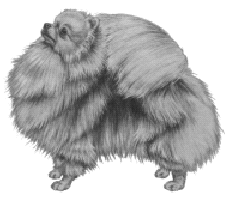Pomeranian
General Information - Pomeranian

Group:
Toy
Size:
Small
Lifespan:
12-16 years
Exercise:
Very little
Grooming:
Moderate
Trainability:
Very hard
Watchdog Ability:
Very high
Protection Ability:
Very low
Area of Origin:
Germany
Date of Origin:
1800s
Other Names:
None
Original Function:
Companion
History
The smallest member of the Spitz family, the Pomeranian boasts tough sledding dog ancestors. Developed in the Prussian region of Pomerania, the Pomeranian was originally descended from the ancient Spitz breeds of the far north which were brought to Europe and employed to herd sheep. Only when the breed was taken to England was it dubbed the Pomeranian, but these early dogs were not the 'Poms' known today. They weighed as much as 30 pounds and were often white. In fact, the Japanese Spitz closely resembles these early Pomeranians and very likely descends from them. Marie Antoinette, Emily Zola and Mozart all owned Pomeranians. In the late 1800s Queen Victoria became a Pomeranian fancier, and established her own kennel for their breeding. She showed her dogs, with some success, making the breed very popular in England. Because Queen Victoria preferred smaller dogs, many breeders began selecting for smaller size. Now the Pomeranian has been bred down from its original size to customary 4-5 pounds. The Pomeranian's intelligence and talent for showmanship has also made it a superior circus performer. This miniature sled dog always attracts admirers and is a very popular pet and show dog.
Temperament
The Pomeranian is a curious, lively and playful dog breed. This dog makes a good companion and enjoys extra attention. The Pomeranian makes a good watch dog and may bark at the approach of strangers and unknown pets.
Upkeep
The Pomeranian is active but diminutive, needing daily exercise but able to meet its needs with indoor games or short walks. Although it has a warm coat, it is too small and too family-oriented to live as an outdoor dog. Its double coat needs brushing twice weekly, more when shedding.
Pomeranian
A breed standard is the guideline which describes the ideal characteristics, temperament, and appearance of a breed and ensures that the breed is fit for function with soundness essential. Breeders and judges should at all times be careful to avoid obvious conditions and exaggerations, as well as being mindful of features which could be detrimental in any way to the health, welfare or soundness of this breed.
Breed Standard - Pomeranian 
General Appearance: Compact, short-coupled dog, well knit in frame. Exhibiting great intelligence in expression; activity and buoyancy in deportment.
Characteristics: Sound, vivacious and dainty.
Temperament: Extrovert, lively and intelligent.
Head and Skull: Head and nose foxy in outline, skull slightly flat, large in proportion to muzzle which finishes finely and free from lippiness. Nose black in white, orange and shaded sable dogs; brown in chocolate-tipped sable dogs, but in other colours may be self-coloured, never parti-coloured or flesh.
Eyes: Medium size, slightly oval, not full, or set too wide apart; bright, dark and showing great intelligence. In white, orange, shaded sable and cream dogs, rims black.
Ears: Relatively small, not set too wide apart, nor too low down, but carried perfectly erect.
Mouth: Jaws strong, with a perfect, regular and complete scissor bite, i.e. upper teeth closely overlapping lower teeth and set square to the jaws.
Neck: Rather short and well set into shoulders.
Forequarters: Shoulders clean and well laid back. Fine-boned legs, perfectly straight, of medium length in due proportion to size of dog.
Body: Back short, body compact, well ribbed up, barrel well rounded. Chest fairly deep, not too wide but in proportion to size of dog.
Hindquarters: Fine-boned, legs neither cow-hocked nor wide behind; medium angulation.
Feet: Small, compact and cat-like.
Tail: Characteristic of breed, high set, turned over back and carried flat and straight, profusely covered with long, harsh, spreading hair.
Gait/movement: Free moving, brisk and buoyant.
Coat: Two coats, an undercoat and an outer coat. Former soft, fluffy; the latter long, perfectly straight, harsh in texture and covering whole of body; very abundant round neck and fore part of shoulders and chest; forming frill, extending over shoulders. Forequarters well feathered, thighs and hindlegs well feathered to hocks.
Colour: All colours permissible, but free from black or white shadings. Whole colours are: white, black, brown, light or dark, blue as pale as possible. Orange which should be self-coloured and bright as possible. Beaver. Cream dogs have black noses and black eye rims. Whites must be quite free from lemon or any other colour. A few white hairs, in any of the self-coloured dogs permissible but undesirable. Dogs (other than white) with white or tan markings highly undesirable and not considered whole coloured specimens. Merles not permissible. In parti-coloured dogs, colours evenly distributed on body in patches; a dog with white or tan feet or chest not a parti-coloured dog. Shaded sables should be shaded throughout with three or more colours, the hair to be as uniformly shaded as possible, and with no patches of self-colour. In mixed classes, where whole coloured and parti-coloured Pomeranians compete together, the preference should, if in all other points they are equal, be given to the whole coloured specimens.
Size: Ideal weight -
dogs: 1.8 to 2 kgs (4 to 4 1/2 lbs); bitches: 2 to 2.5 kgs (4 1/2 to 5 1/2 lbs).
Faults: Any departure from the foregoing points should be considered a fault and the seriousness with which the fault should be regarded should be in exact proportion to its degree and its effect upon the health and welfare of the dog.
Note: Male animals should have two apparently normal testicles fully descended into the scrotum.
DNZ No 156
Copyright Dogs New Zealand
30 May 2018
Any departure from the foregoing points should be considered a fault and the seriousness with which the fault should be regarded should be in exact proportion to its degree and its effect upon the health and welfare of the dog and on the dog’s ability to perform its traditional work.





